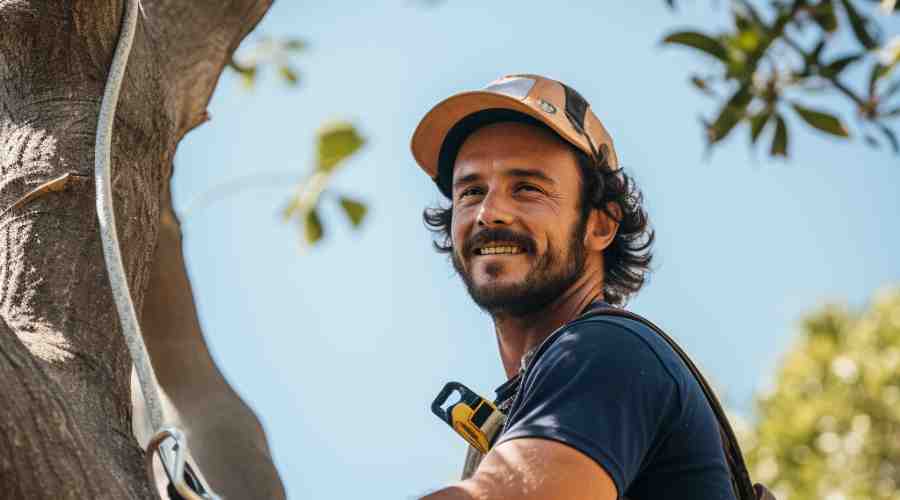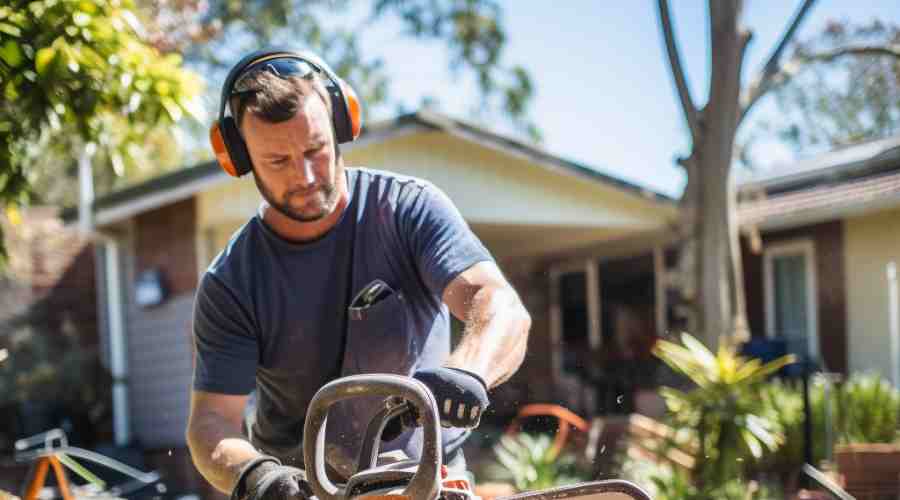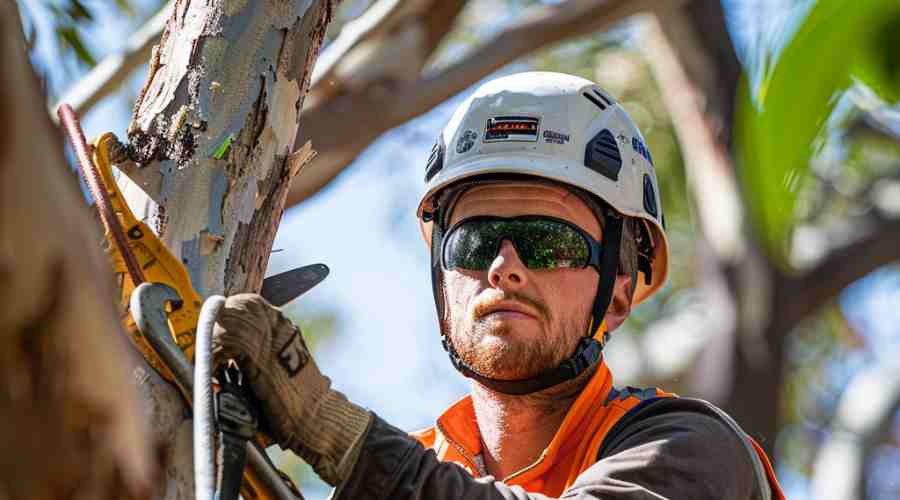Tree Removal Safety Guide
Safety First: Managing Risks During Tree Removals
Having a tree removed from your property can be a necessary but potentially dangerous job. With chainsaws buzzing, ropes flying, and heavy branches crashing down, ensuring safety should be your top priority.
This guide covers key safety aspects to consider when getting a tree professionally removed or doing it yourself. We’ll explore how to choose a qualified arborist, prepare your property, use proper safety gear, and handle the tree removal safely from start to finish.
Whether it’s storm damage, disease, or just an overgrown tree, follow these safety tips for a smooth removal process.
1. Choose a Qualified Arborist Carefully
Hiring a professional, fully-insured tree removal company is highly recommended over tackling the job yourself. However, not all pros are equal in skill and safety practices.
Here are tips for choosing a qualified tree service:
- Check certifications and licenses. Make sure they employ ISA-certified arborists and have all state and local licenses.
- Ask for proof of insurance. Request at least $1 million in liability coverage and workers’ compensation.
- Get references. Talk to past clients about their safety practices and professionalism.
- Compare services. Get quotes from 3-5 tree companies detailing their safety protocols.
- Check equipment. Make sure ladders, ropes, saddles, saws, and trucks are well-maintained.
Reputable arborists will have safety documentation readily available and be happy to answer all your questions thoroughly.
2. Inspect and Prepare the Property
Before starting the removal, the experts should carefully inspect the tree, your property, and surrounding area for any common risks or obstacles.
- Scan inside the tree’s canopy for hazards like dead branches or animal nests.
- Check for nearby power lines or structures like a house or shed.
- Make sure the area under the tree’s reach is completely clear of vehicles, play equipment, landscaping, etc.
- Clean the workspace by removing debris and trimming bushes or overhanging limbs.
It’s also crucial to notify neighbors of the scheduled work, especially if heavy equipment will be blocking the road temporarily.
3. Use Proper Safety Gear
Whether you’re the homeowner or tree removal crew, wearing the appropriate gear from head to toe is an absolute must.
Essential Gears
- Hard hat with face screen
- Safety goggles for eye protection
- Hearing protection – noise reducing earplugs or earmuffs
- Heavy work gloves
- Long sleeve shirt and pants
- Steel toe boots with ankle support and non-slip soles
- High visibility vests
Professional arborists will also use:
- Climbing saddles and fall restraints
- Chainsaw chaps
Having a well-stocked first aid kit and fire extinguishers on hand are also vital safety measures.
4. Follow Safe Tree Removal Procedures
From initial inspection and equipment set up to the final cleanup, tree surgeon must adhere to safety best practices at every stage when removing a tree.
Safe Tree Removal Process
- Inspect – Check tree, gear, and site thoroughly first.
- Equipment set up – Ensure trucks, wood chippers, safety tools, ropes, signs, and barriers are properly positioned.
- Prepare work zones – Establish drop zones, entry/exit routes, alternative access points if needed.
- Limb removal – Remove all limbs safely before touching the main trunk.
- Trunk removal – Precise cuts to fell the main trunk safely. Use wedges, leave holding wood.
- Lower limbs/trunk – Lower large pieces carefully with ropes.
- Chip brush – Shred small branches and debris with wood chipper.
- Clean site – Double check area is clean and safe before leaving.
At every step, attention to safety should come before speed or shortcuts. Rushing leads to mistakes and injuries. Efficiency improves naturally with experience.
Proper preparation, constant communication, choreographed movements, and caution cannot be overemphasized enough during the tree removal process.
Special Safety Considerations
Certain tree removal scenarios call for additional safety planning and precautions.
Overhead Power Lines
Trees growing close to utility lines require utility company involvement, strict precautions, and expert skills.
- Utility company must disengage/reroute electrical service before work begins.
- Use non-conductive ropes and eliminate use of metal ladders or poles.
- Set up strict ground worker safety zones.
- Carefully rig twigs to fall safely away from the lines.
- Allow freshly cut limbs to sit for 48 hours before removal to reduce conductivity.
Storm-Damaged Trees
Storms can leave uprooted, cracked, or dangerously leaning trees.
- Inspect from all angles for not just broken branches but trunk/root cracks.
- Rig strong support cables/ropes before cutting if needed to control fall.
- Consider sectioning the tree or using machinery to lessen ground impact.
- Make clean cuts at fork points or through cracks instead of cutting whole trunk initially.
Dead Trees
Rotten or hollow wood requires adjusting rigging, angles, equipment to address unique risks.
- Probe tree thoroughly testing wood integrity since decay is hidden.
- Use wedges strategically to aim cracks/breaks away from houses or workers.
- Remove dead branches in sections using multiple rigging lines for control.
- Inspect climbing ropes/gear rigorously for defects from friction with dead wood.
With extra diligence taken for these special scenarios, tree removals and clean ups can be done safely reducing personal, home, and utility line damage.
Aftercare and Prevention
Once the tree removal job is complete, follow up care is still essential.
- Inspect the site – Check for leftover wood chips, branches, and property damage missed initially.
- Talk to the arborist – Discuss if disease prevention spray or fertilization is recommended for remaining trees.
- Choose replacement trees wisely – Select species apt for the yard space and soil that won’t endanger utilities or structures long-term.
- Update landscaping accordingly – With more sunlight or empty space, add or move plants and hardscapes to match.
Prevention is also key to avoid future unsafe tree situations:
- Maintain trees routinely – Prune, treat disease, remove potential hazards on a schedule.
- Monitor tree health annually – Catch decline signs early like thinning canopy or fungi growth.
- Consult certified arborists about concerns – Don’t delay suggested mitigation steps.
- Prepare properly for storms – Keep yards clear of falling limb hazards.
Following these tree care and readiness steps will optimise safety for people, pets, and property for years to come.
Conclusion
Removing a hazardous tree presents safety risks that need diligent safety steps. By hiring qualified arborists, preparing your property fully, using proper gear, and following strict procedures through the job, tree removals and cleanups can happen without incident.
Keep this tree removal safety guide on hand when that needed project comes up. Making sure everyone’s safety makes a smooth process from start to end more possible. Your household and the tree worker will value the extra care taken to trim, cut down, and clear the tree safely.



